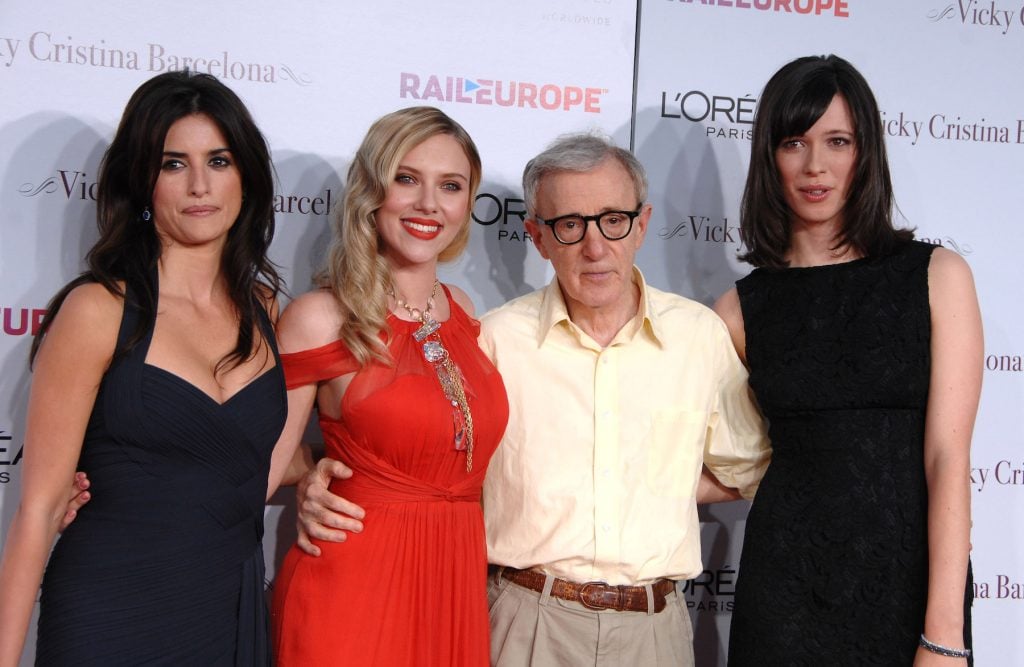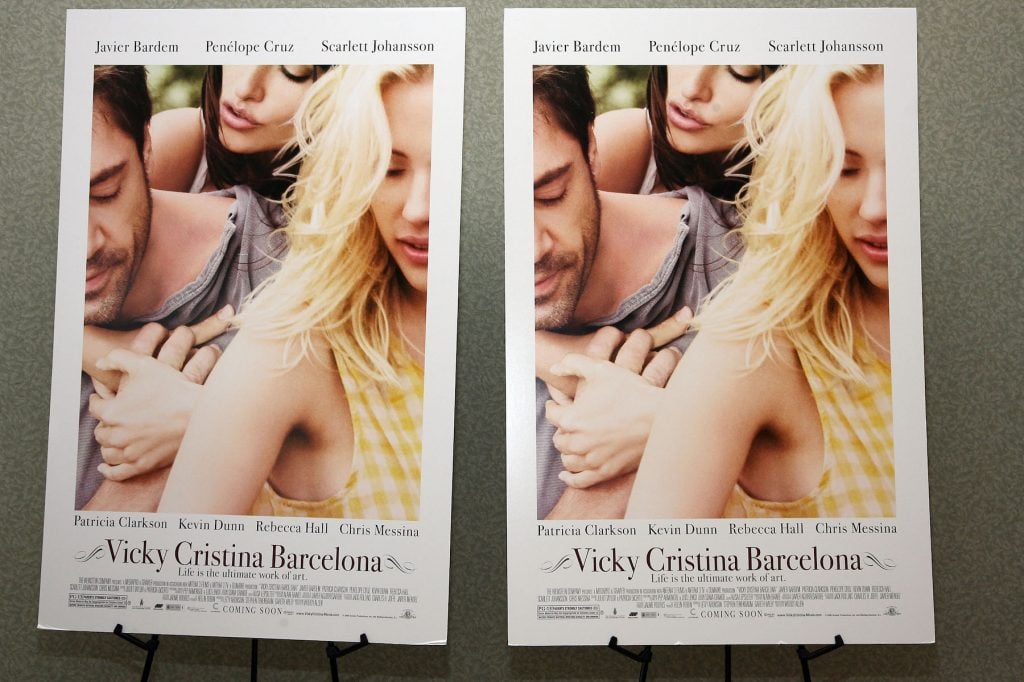Pop Culture
Creepily, the Woody Allen Romp ‘Vicky Cristina Barcelona’ Channels the Book That Outed Picasso’s Treatment of Women
Penelope Cruz's character is a lot like Dora Maar.

Penelope Cruz's character is a lot like Dora Maar.

Ben Davis

Here’s an odd footnote to the whole conversation about Picasso in pop culture, coming off the kerfuffle around Hannah Gadsby’s “Pablo-matic” show at the Brooklyn Museum. As I was researching Picasso’s life while writing about that show I read Françoise Gilot’s memoir Life With Picasso. I had a feeling of deja vu, and I realized that was because I had recently seen Woody Allen’s Vicky Cristina Barcelona.
The more I think about it, the more certain I am that Vicky Cristina Barcelona—a late-period, but pre-Vanity Fair exposé trifle from Allen—is channeling Gilot’s tell-all. Which is unsettling, for reasons I’ll explain.
Here’s my case. Vicky Cristina Barcelona tells the tale of two young American women visiting Barcelona, who are swept up into a multi-cornered love affair with a lusty Spanish painter, Juan Antonio (played by Javier Bardem). Obviously, Françoise Gilot’s book is set in the 1940s, not the 2000s; it’s set in France, not Spain; and Gilot herself is French, not American. But the fact that Bardem’s artist draws on the archetype of Picasso as a sex god was noted on the film’s release.
Picasso, of course, is connected with Barcelona. In fact, the “little restaurant” where Vicky (Rebecca Hall) and Cristina (Scarlett Johansson) first meet Juan Antonio in the film is Els Quatre Gats, the Barcelona hangout where Picasso had his first show, which to this day features a Picasso artwork on its menu. In Gilot’s book, she describes first meeting with Picasso at a Paris spot called… La Catalan.
That first-meeting scene is mirrored between My Life With Picasso and Vicky Cristina Barcelona. In Allen’s film, after spying Juan Antonio at an art opening and hearing gossip about him as “the painter with the bad divorce,” the two friends—Vicky being depicted as more practical, Cristina the more free-spirited—glimpse him at the restaurant, noticing him eyeing them across the room. He then boldly approaches their table and invites him to come away with him to Oviedo to see a sculpture that he finds inspiring.
In Gilot’s description of her meeting with Picasso, she and her friend Genevieve spot the famous painter at La Catalan, noting Picasso eyeing them from across the room. He then boldly comes over to proposition them. A mutual friend offers an introduction: “Françoise is the intelligent one. Genevieve is the beautiful one.” Both women are painters. “Well… I’m a painter, too,” Picasso is quoted as saying. “You must come to my studio and see some of my paintings.”
Vicky Cristina Barcelona, like Life With Picasso, is about the fascinations and complications of entering into a painter’s bohemian sexual lifestyle. Vicky, an intellectual, and Cristina, an artist, form a kind of composite Gilot, who was both an intellectual and an artist. In Allen’s film, both characters move into and out of romantic entanglement with Juan Antonio.
Allen’s movie climaxes with Juan Antonio trying to coax Vicky back into bed with him, arguing that she is not happy with her boring and conventional new husband; Gilot’s book ends with Picasso begging Gilot to be with him again, arguing that she will never be satisfied with her boring and conventional new fiancé (artist Luc Simon; Gilot would go on to marry polio vaccine inventor Jonas Salk).

Posters dispalyed at the screening of Vicky Cristina Barcelona at the Southampton Cinema. Photo by Kevin Kane/Getty Images.
Vicky Cristina Barcelona is best remembered as the vehicle that won Penelope Cruz an Oscar for her very memorable role as Maria Elena, Juan Antonio’s ex-wife who pops back up to create zany complications for his budding romance with the two Americans because of her fiery and possessive nature. In Gilot’s book, the constant return of Picasso’s various lovers is a central thread. Cruz’s Maria Elena seems a composite of two specifically: Olga Khokhlova and Dora Maar. Khokhlova was Picasso first wife, and Gilot describes her as stalking and even attacking her out of jealousy, and barging into their home to live with her and Picasso, to Picasso’s bemusement and irritation. Dora Maar was, like Maria Elena, an art photographer and painter with a flair for the dramatic—not to mention a past where they fought violently.
In Gilot’s book, Picasso at one point has to deal with Dora Maar’s mental breakdown, seemingly triggered by the stress of their breakup (Picasso would send Maar to be treated by Jacques Lacan). In Vicky Cristina Barcelona, Juan Antonio has at one point to go to aid Maria Elena when she attempts suicide, prompting the second-act complication where Maria Elena comes to his house to live with Juan Antonio and Cristina while she recovers.
(“I don’t trust her, Juan Antonio,” Cruz’s character says upon seeing Johansson’s Cristina. “Her eyes are not one color.” Françoise Gilot had heterochromia—different colored eyes.)

Françoise Gilot at the Plaza Hotel on November 19, 2015 in New York City.
The Life With Picasso inspiration is not one that Allen mentioned openly, to my knowledge—to the contrary, he told Collider he “had the idea about two women going away on a summer thing some place,” and improvised the script around the city of Barcelona (which partly funded it). Three years later, Pablo Picasso appeared as a character for Allen in the ebulliently goofy Midnight in Paris.
But whether it’s coincidence, unconscious influence, or coded homage, the parallel between Vicky Cristina Barcelona and Life With Picasso is unnerving because the latter is not just any book about Pablo Picasso. It’s particularly remembered as the source of a lot of the negative stories about the painter: the time he burned Gilot with a cigarette, saying he wanted to brand her; the time he terrorized her friend Genevieve with unwanted sexual advances, a ploy to scare her away and isolate Gilot from her. Above all, it details Picasso’s controlling and childish treatment of the women in his life.
Placing the two works side by side, it feels as if Allen took this tale about the troubling underside of the myth of the force-of-nature male genius, and then just tweaked it to leave out the “troubling underside” part. Gilot’s Picasso is selfish and manipulative; she speaks of his “standard technique of using people like ninepins, of hitting one person with the ball to make the other fall down.” Woody Allen’s Picasso-esque painter is caring and generous; instead of being played off against each other, the women in his life are drawn into a spicy three-way romance by his sheer sexual magnetism.
Obviously, Vicky Cristina Barcelona doesn’t claim to be anything other than a fun romp. But equally obviously, given the charges that did and do hover around Woody Allen, it’s difficult not to look back on the sexual politics of all his works with a suspicious eye. And there would be something particularly telling about Woody Allen picking up the book that told the story of Picasso’s dark side and thinking, “what a delightful character.”